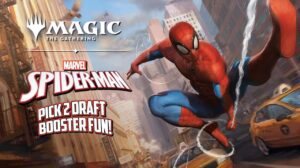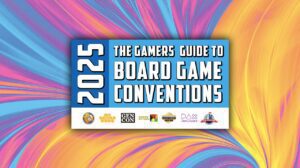Over a decade since its 2012 debut, Cryptozoic Entertainment’s DC Deck-Building Game continues to provide top-notch gameplay experiences for tabletop fans and comics aficionados alike. With dozens of flavorful Crossover packs, cooperative Crisis expansions, and head-to-head Rivals options, the number of characters, continuities, and worlds available to players of this deckbuilder now rivals the greater DC comics canon. A question emerges: does the core experience of the series’ original base game, without the mechanical bells and whistles of later expansions, still hold up?
A Deck Builder Uniting Comic Fans and Tabletop Strategists
Fans of the deck building genre will immediately recognize a few of DC Deck-Building Game’s core conceits: you begin with a deck of Starter cards—Punches and Vulnerabilities—that are used to progressively upgrade and sculpt a deck capable of impressive feats. Each turn sees players drawing a hand of five cards and playing out their hand with the hopes of adding the best available cards to their deck by way of their discard pile. If a player attempts to draw from an empty deck, they shuffle their discard pile to create a new deck, and continue their turn from there. As the game progresses, players can amass more and more powerful cards while destroying less valuable additions for increased consistency and stronger turns. Each player’s goal is to end the game with a deck worth the highest number of VP (or Victory Points), and there are numerous ways to accomplish this goal.

Anchoring the deck building process are oversize Super Hero cards provided to each player as the game begins. These cards—which in the base set feature Justice League mainstays like Batman, Wonder Woman, and Cyborg—provide guidelines to players for deck-building and card sequencing that often lead each player’s deck to function in uniquely synergistic ways. Playing as The Flash automatically makes the player take their turn first and encourages buying cards that help you draw extra cards, while Superman rewards players for each unique Super Power they play during each of their turns. Because some of the Super Heroes’ build-around card types and mechanics overlap with each other, players will need a combination of luck and deft card evaluation to gain ground against each other. Key cards for each Super Hero’s strategy often feature the character in some way, creating simple but elegant ‘signposts’ that help players identify which cards they should prioritize as they show up in the Line Up.
Getting Into The Thick of Gameplay
Each game of DC Deck-Building Game centers around purchasing cards from a diverse and ever-shifting Line Up of Heroes, Villains, Equipment, Super Powers, and Locations from all across the DC universe. Fittingly, the primary currency of the game is Power. Power is used to add cards from the Line Up to players’ decks as well as to defeat high-powered Super Villain cards, which are set aside during the game’s setup. (More on this later.) Punches are available from the beginning and are worth +1 Power each, while cards with higher buying costs usually translate to greater Power yields, such as Superman’s signature 7-cost Super Power, Super Strength, which is worth a massive +5 Power on its own. For scale, on the first turn of the game, the highest-Power scenario for a player is to draw five Punches and zero Vulnerabilities, totalling five Power across five cards.
In the early game, players may find themselves unable to assemble hands with enough Power to acquire high cost cards from the Line-Up, but always-available Super Power cards like Kicks, which cost 3 Power to purchase and add +2 Power when played, help to ramp up each player’s output. As players gain access to their build around cards and mechanics, distinct strategies and play styles often reveal themselves, though the size of the main deck and the variance inherent to the game’s genre can lead some players dipping into other strategies in absence of options that directly synergize with their game plan.
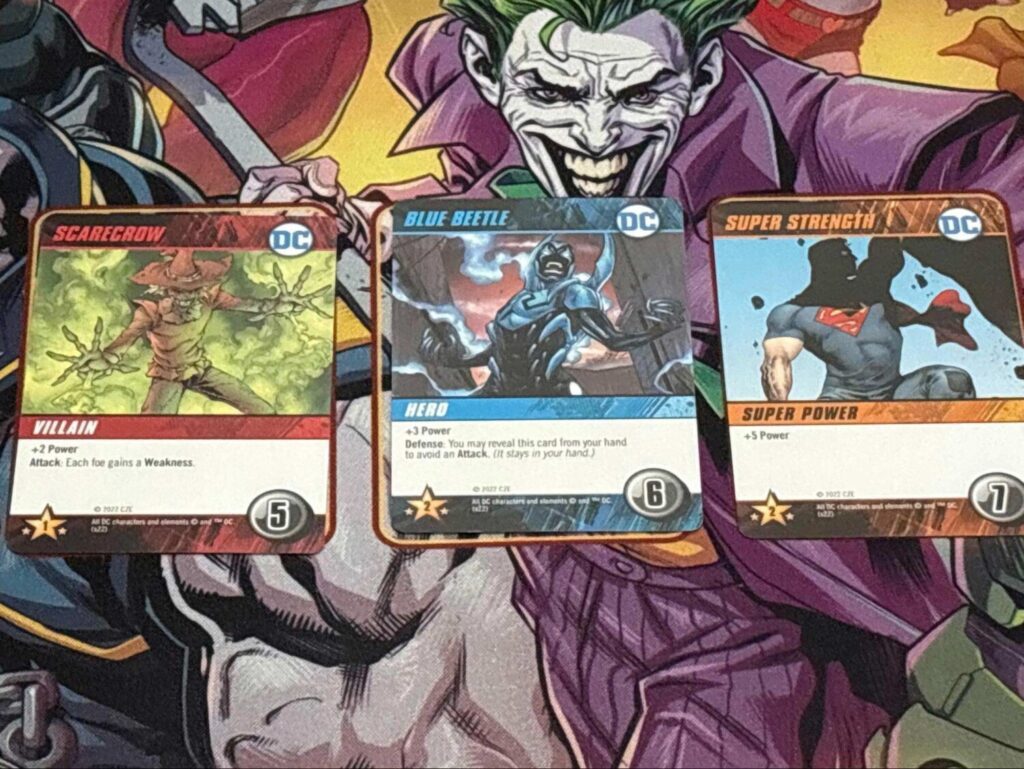
Many deck builders can feel a bit like solitaire, lacking the element of interaction between players that gives card games like Magic: The Gathering their zest and appeal. Fortunately, DC Deck-Building Game avoids this shortcoming with the presence of Attack and Defense cards. Attacks are usually found on Villain cards and inflict some kind of negative effect on one or more players, like forcing them to discard a card or add a negative-VP Weakness card to their discard pile. When one player manages to get an early lead, Attacks can help level the playing field and keep players from snowballing toward victory. Equally important to the game’s interactive formula are Defense cards, which can be discarded to provide a layer of protection in response to Attack cards, usually with some sort of added benefit like card draw or card selection. Some Defense cards, like the 6-cost Blue Beetle, can be used repeatedly during a turn rotation, defending players merely by being revealed from hand, making them very desirable additions.
Building Decks With A Purpose: Glorious Victory Over Evil
Defense cards are premium pick ups for any strategy, as players are not only avoiding Attacks from other players, but from other forces within the game: Super Villains. While players spend much of the game cycling through the Line Up’s offerings, gradually improving their deck’s quality and consistency, players’ primary goal is to defeat as many of the assembled Super Villains as possible. During setup, a stack of progressively higher-cost and higher-impact Super Villain cards is set to the side of the Line Up. These extra-powerful cards serve as both an outlet for players to use their accumulated Power and, as the game’s pace speeds up, a welcome source of gameplay disruption.
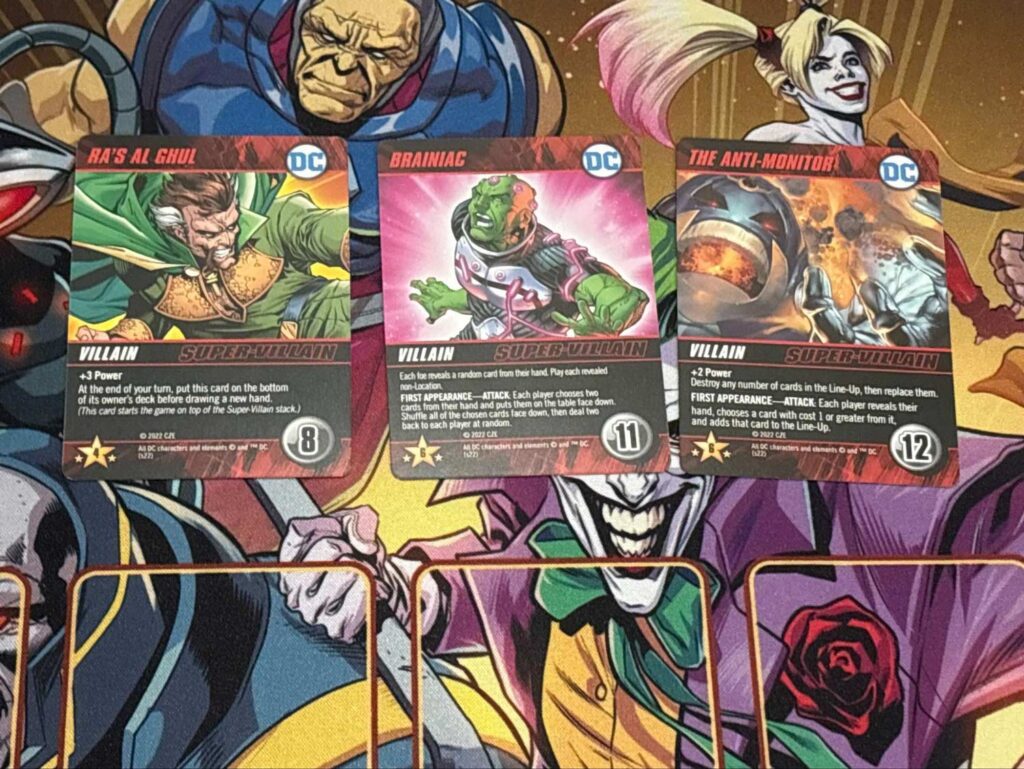
Defeating a Super Villain adds that card to a player’s discard pile like gaining any other card, and each comes with a considerable VP value, but when one evil falls, another rises to take its place. With the exception of the first revealed Super Villain, each Super Villain has a ‘First Appearance – Attack’ that inflicts a table-wide penalty that can easily derail player’s best laid plans, so players will be encouraged to purchase Defense cards for their deck to protect their hands and keep their decks from being gummed up by Weakness cards. When the last Super Villain is defeated, or there are no additional cards to add to the Line Up, the game ends, so players can find themselves deciding between pushing the game to end early to maintain their VP lead or extending the game until their deck’s synergies can enable them to buy the entire contents of the Line Up turn after turn.
DC Deck Building Game Does Exceptional Justice To Its Source Material
One criticism is that because the base set was designed to encompass the core cast of Heroes and Villains of DC comics, it lacks a unified mechanical identity, feeling more like a kitchen sink set over-stuffed with ideas. When compared to later sets like Heroes Unite, which prominently feature various shades of the Lantern Corps (as well as their Power Rings), the base set throws a lot at the wall to see what sticks. However, these qualities are a large part of what makes the base set so replayable. Although there are multiple copies of many of the set’s cards available to acquire in a given game, some combos and win conditions won’t be discovered until late into a first playthrough, if they present themselves at all.
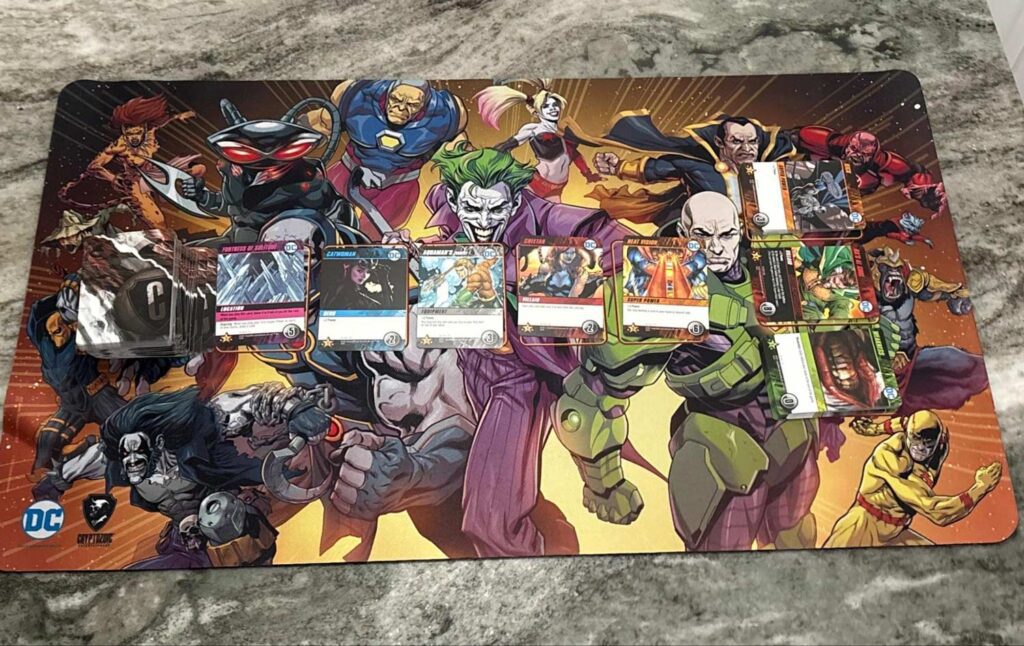
Cryptozoic’s Cerberus Engine, distinguished by its recognizable mechanics that can be easily mapped onto a variety of creative properties, helps to make the DC Deck-Building Game’s complex rules not only make sense, but feel engaging and welcoming to veteran tabletop players and newbies alike. The elegance of the way Cryptozoic devised this engine is undoubtedly the secret to the series’ success—not to mention its longevity. Even as the series has piled on new elements and gimmicks to keep each new set’s play experience feeling fresh, the core experience DC Deck-Building Game started with remains exciting and engaging, helping players feel as formidable and intelligent as their favorite DC characters.
A combination of flavorful card effects, iconic artwork, and an expansive (but not exhaustive) survey of DC Comics most memorable heroes, villains, and locales makes every game feel powerful and unique. Even if you can take or leave the superhero aesthetic it offers, DC Deck-Building Game’s first set is a feast for fans of the deck builder genre, worthy of the devotion it has garnered over its decade-plus-long history.




